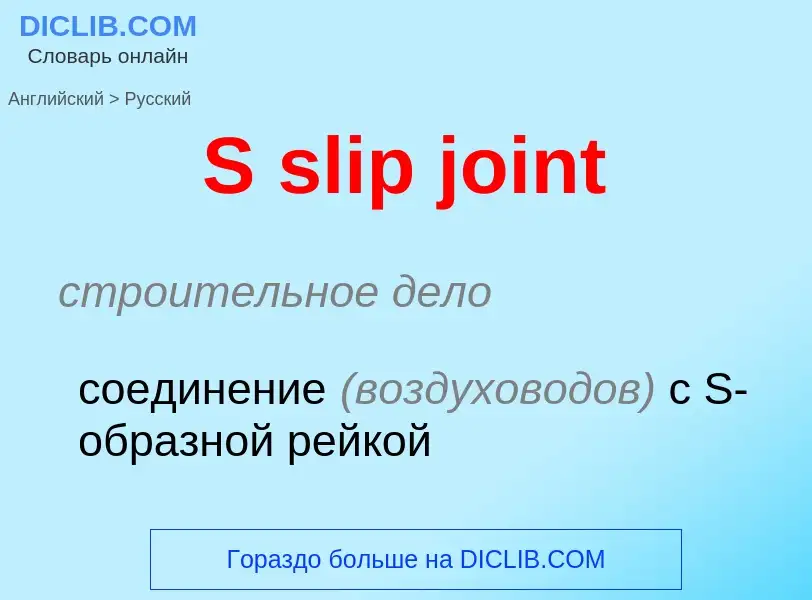Tradução e análise de palavras por inteligência artificial
Nesta página você pode obter uma análise detalhada de uma palavra ou frase, produzida usando a melhor tecnologia de inteligência artificial até o momento:
- como a palavra é usada
- frequência de uso
- é usado com mais frequência na fala oral ou escrita
- opções de tradução de palavras
- exemplos de uso (várias frases com tradução)
- etimologia
S slip joint - tradução para Inglês
строительное дело
соединение (воздуховодов) с S-образной рейкой
[in'gəub]
существительное
общая лексика
ангоб (в керамике)
Definição
Wikipédia
Slip-critical joint, from structural engineering, is a type of bolted structural steel connection which relies on friction between the two connected elements rather than bolt shear or bolt bearing to join two structural elements.
Shear (and tension) loads can be transferred between two structural elements by either a bearing-type connection or a slip-critical connection.
In a slip-critical connection, loads are transferred from one element to another through friction forces developed between the faying surfaces of the connection. These friction forces are generated by the extreme tightness of the structural bolts holding the connection together. These bolts, usually tension control bolts or compressible washer tension indicating type bolts, are tensioned to a minimum required amount to generate large enough friction forces between the faying surfaces such that the shear (or tension) load is transferred by the structural members and not by the bolts (in shear) and the connection plates (in bearing). The "turn of the nut" method is also widely used to achieve that state of friction.
If slip-critical connections fail (by slipping), they revert to bearing-type connections, with structural forces now transferred through bolt shear and connection plate bearing. Thus a slippage failure of a slip-critical connection is not necessarily a catastrophic failure. However, slippage of a slip-critical connection in columns may lead to column instability. Slippage of a slip critical joint in a roof truss could result in unintended ponding effects.
The faying surfaces of slip-critical connections must be properly prepared in order to maximize friction forces between the surfaces joined. Usually, this requires cleaning, descaling, roughening, and/or blasting of the faying surfaces. Painting the faying surfaces with a class B primer also allows being in accordance with most of the design that asks for Slip-critical joint.

![[[African red slip ware]]: moulded [[Mithras]] slaying the bull, 400 ± 50 AD. [[African red slip ware]]: moulded [[Mithras]] slaying the bull, 400 ± 50 AD.](https://commons.wikimedia.org/wiki/Special:FilePath/African cup in terra sigillata with moulded interior decoration showing Mithras slaying the bull, from Lavinium, second half of 4th century - first half of 5th century AD, Museo Nationale, Rome (9442849659).jpg?width=200)
![Charger with Charles II in the [[Boscobel Oak]], English, c. 1685. The plate's diameter is 43 cm; such large plates, for display rather than use, take slip-trailing to an extreme, building up lattices of thick trails of slip. Charger with Charles II in the [[Boscobel Oak]], English, c. 1685. The plate's diameter is 43 cm; such large plates, for display rather than use, take slip-trailing to an extreme, building up lattices of thick trails of slip.](https://commons.wikimedia.org/wiki/Special:FilePath/Charger of Charles II in the Boscobel Oak LACMA M.86.151.jpg?width=200)
![Chinese [[Cizhou ware]] vase with cut-glaze decoration Chinese [[Cizhou ware]] vase with cut-glaze decoration](https://commons.wikimedia.org/wiki/Special:FilePath/MET DP274692.jpg?width=200)
![[[Phoenicia]]n plate with red slip, now wearing away, 7th century BC [[Phoenicia]]n plate with red slip, now wearing away, 7th century BC](https://commons.wikimedia.org/wiki/Special:FilePath/Phenician plate with red slip 7th century BCE excavated in Mogador island.jpg?width=200)
![[[Miletus ware]] showing a red body covered by white slip, then painted in blue, c. 1400, [[Turkey]] [[Miletus ware]] showing a red body covered by white slip, then painted in blue, c. 1400, [[Turkey]]](https://commons.wikimedia.org/wiki/Special:FilePath/Miletus ware showig red clay base.jpg?width=200)
